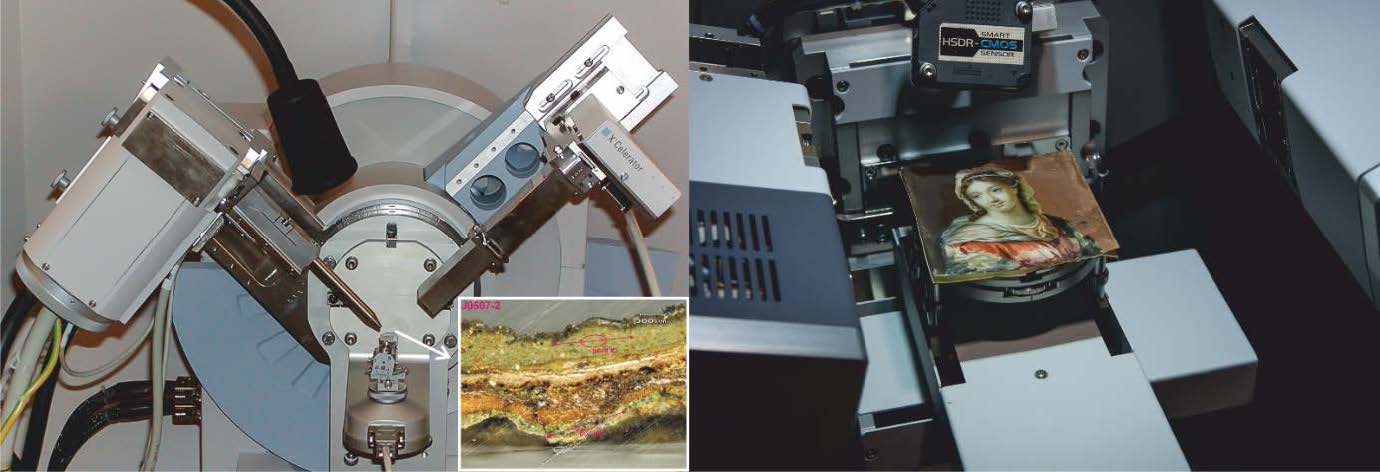Nanoseminar
Group of Structure analysis at the Department of Condensed Matter Physics
of Charles University and MGML has a pleasure to invite you to attend the seminar on nanomaterials: Physics, Technology, Applications
on 25th April 2024 at 14:00
at Faculty of Mathematics and Physics of Charles University, Ke Karlovu 5, 121 16 Praha 2
Lecture room F2
Silvie Švarcová
Institute of Inorganic Chemistry of the Czech Academy of Sciences, ALMA Laboratory, Husinec 1001, 250 68 Husinec-Řež, Czech Republic
Laboratory X-ray Powder Diffraction in the Research of Painted Artworks
Silvie Švarcová » Laboratory X-ray Powder Diffraction in the Research of Painted Artworks
Institute of Inorganic Chemistry of the Czech Academy of Sciences, ALMA Laboratory, Husinec 1001, 250 68 Husinec-Řež, Czech Republic
Keywords: XRPD, Paintings, Origin, Degradation
*corresponding author: e-mail: svarcova@iic.cas.cz
Location: Lecture room F2, MFF UK, Ke Karlovu 5
Materials in painted artworks (i.e., panel, easel and miniature paintings, wall paintings, polychromed sculptures and other objects decorated by paint layers) represent an extensive set of inorganic and organic phases, which are often present in complicated mixtures and exhibit characteristics reflecting either their geological genesis (mineral pigments), manufacturing technology (artificial pigments) or diverse biological nature (binders or dyes). The resulting painting technique, i.e., the artists’ choice of the painting materials and the way of their application, is influenced both by local availability of materials [1] as well as by iconographic convention, period style, workshop/artists’ preferences or regional tradition [2]. To complicate the issue, painting materials tend to change in time. Besides acceptable patina caused by gradual and natural aging of materials, severe degradation can occur, resulting in undesired changes of appearance or endangered stability of artworks [3]. Therefore, the main motivations for material investigation of paintings are i) to describe their painting technique, ii) to identify characteristics suitable for origin/provenance determination and dating of both materials and paintings and iii) to recognise degradation products with the aim to understand the processes of deterioration [1-4]. However, the analyses are often made challenging by the heterogeneous nature and minute size of micro-samples or, in some cases, even by the impossibility of sampling due to preciousness, fragility or small dimensions of the artwork [5]. Nevertheless, laboratory X-ray powder (micro-)diffraction represents a very powerful tool in material investigation of paintings [6] and its efficiency and importance will be illustrated on numerous examples.
 Figure 1. Analytical challenge: analysis of heterogenous micro-sample (left) and delicate miniature painting with prohibited sampling (right) using laboratory XRPD in micro- (left) and conventional (right) set-up.
Figure 1. Analytical challenge: analysis of heterogenous micro-sample (left) and delicate miniature painting with prohibited sampling (right) using laboratory XRPD in micro- (left) and conventional (right) set-up.
References:
[1] Hradil, D., Hradilová, J., Bezdička, P., (2020). Minerals 10, 255.
[2] Hradil, D., Hradilová, J., Bezdička, P., Švarcová, S., (2008). X-ray Spect. 37, 376.
[3] Kotulanová, E., Bezdička, P., Hradil D., Hradilová, J., Švarcová, S., et al, (2009). J. Cult. Her.10, 367.
[4] Švarcová, S., Kočí, E., Bezdička, P., Garrappa, S., Kobera, L., et al., (2020). Dalton Trans. 49, 5044
[5] Hradilová, J., Hradil, D., Pech M., Bezdička, P., Neděla, V., et al., (2020). Microchem. J. 153, 104371
[6] Švarcová, S., Kočí, E., Bezdička, P., Hradil, D., Hradilová, J., (2010). Anal. Bioanal. Chem. 398, 1061
Acknowledgement:
The special acknowledgement is addressed to all present and former members of the ALMA Laboratory as well as owners of artworks and numerous co-workers from the field of restoration, conservation and art history, who have contributed to deepening the knowledge of materials in paintings. The work was supported by the Czech Academy of Sciences within the frame of research programme Strategy AV21 No. 23 - City as a Laboratory of Change; Historical Heritage and Place for Safe and Quality Life and by the Czech Science Foundation, project No. 22-17966S.


